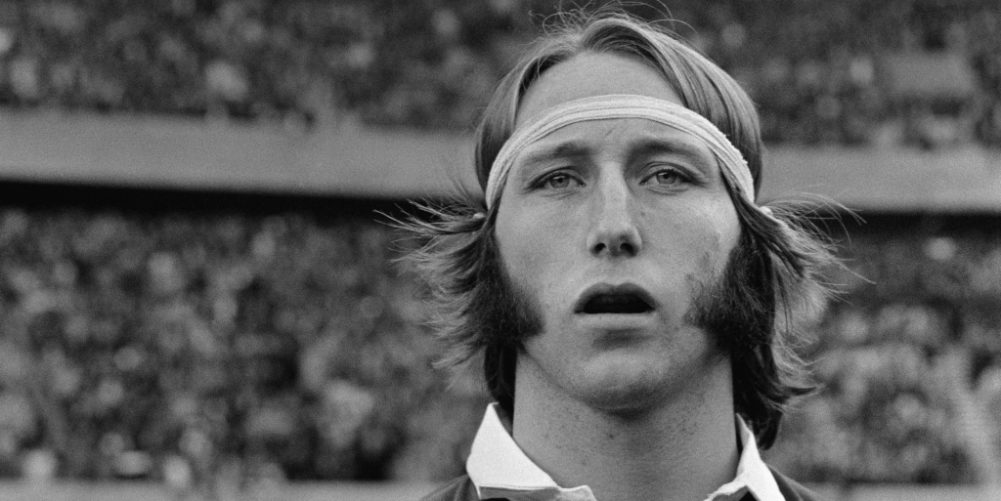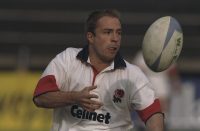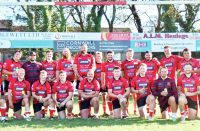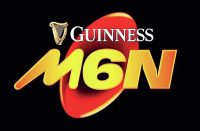Brendan Gallagher continues to shine the light of the best who have graced the rugby field and excelled in the medical profession.
After beginning the series earlier this week, where Wales centre Jamie Roberts featured, here are ten more remarkable figures.
10. Rudi Van Vuuren (Namibia)
Not only did he train as a doctor but when he graduated the AIDS epidemic was sweeping through southern Africa and, as well as normal GP duties, he was thrown into that life and death battle. Meanwhile he did not abandon his sporting ambitions.
He had always targeted a unique double in 2003, to play in both the Rugby World Cup and Cricket World Cup. The latter came first and although Namibia got heavily beaten in all their games there was a respectable 2 for 53 against India including the prized wicket of Sachin Tendulkar.
Rugby was his preferred game and Van Vuuren was a high percentage goal kicker and key man for Namibia. Alas, he picked up an injury in Australia but did get a run-out in their final game against Romania thus fulfilling his dream.
“It was a busy year that’s for sure but I never saw it as an impossible task. I could have a dreadful night with a patient dying after a long fight against illness and that was upsetting but life feels better if you have a rugby or cricket match the next morning. And if the sport isn’t going so brilliantly, it’s a great reality check to get back to treating patients.”
9. Karl Mullen (Ireland and Lions)
Captain of both Ireland‘s 1948 Grand Slam side and the 1950 Lions, Dr Karl Mullen enjoyed a distinguished 40-year career based at the Mount Carmel Hospital in Dublin, where he set up and ran the hospital’s busy maternity unit.
It is estimated he took a hand in delivering nearly 40,000 babies before he retired in 2002 and became a fellow of the Royal College of Obstetricians and Gynaecologists.
8. Ronald Cove Smith (Old Merchant Taylors, King’s College Hospital, England and Lions)
A towering figure from the 1920s during which he took a starring role in all four England Grand Slams of that era, beginning as a back row forward, graduating to lock and eventually appearing at prop in the latter stages of his career. Also captained the 1924 Lions in South Africa, the tour party when the term ‘Lions’ first came into common parlance.
Distinguished medical practitioner and administrator who rose to be vice president of the British Medical Association.
7. Claire McLaughlin (Ireland)
The Ireland prop, 28, has already won 18 caps for her country but as a Junior Doctor at the Ulster Hospital’s A&E Department she has found herself in the front line in the fight against COVID-19.
She graduated four years ago and thinks her rugby career has contributed importantly to her ability to cope: “There are certain things that medical school can’t teach you. Leadership, communication and team work are all things that rugby has massively helped me to develop. It’s been hugely important transferring those skills into medicine. I’ve learnt so much through playing rugby.”
6. Jack Matthews (Cardiff, Wales and Lions)
Legendary hardman centre and fitness fanatic who went toe to toe for three rounds with Rocky Marciano during the war when the American was stationed in south Wales and was so fit that after the War the SAS regularly invited him over to Hereford to knock their recruits into shape.
His lifelong passion apart from rugby, though, was his work as a GP in Cardiff for over 30 years and the job back then was very different.
Among many other things, he estimated he helped deliver over 7,000 babies at home and it was bog standard for him to turn up to a Cardiff game on the Saturday having spent most of Friday night and early Saturday morning on house calls.
As his big mate Bleddyn Williams said: “I can tell you, because he was my GP, that Jack was a brilliant general practitioner. He also listened and understood and would always go the extra mile to help.”
Towards the end of his medical career Matthews was able to combine his two great loves when he was appointed the official tour doctor for the 1980 Lions in South Africa.
5. JPR Williams (Wales and Lions)
Incredible performer for London Welsh, Bridgend, Wales and the Lions and it still defies belief, particularly during the early phase of his Test career which incorporated two epic Lions tours and a Wales Grand Slam, that he was also working as medical student and trainee doctor at St Mary’s Hospital in London.
Nor did he ever miss a game for them or Middlesex in the County Championship. JPR appeared to have the energy and physical resources of three or four men.
During the second part of his Test career he worked as a doctor at the University College Hospital in Cardiff and began to concentrate on orthopaedic surgery, eventually becoming the consultant surgeon at the Princess of Wales Hospital in Bridgend, his home town where both his parents were GPs.
His book The Sports Injuries Handbook was essential reading for most sportsmen and sportswomen.
4. Roberto Canessa (Uruguay)
Canessa had already made his Uruguay debut on the wing when, as a 19-year-old medical student, he joined his club Old Christians on a short four-day tour of Chile in October 1972.
Their Uruguayan Airline plane flight 571 crashed high in a remote part of the Andes and rescuers were unable to find them. Canessa, with his then slight medical background, helped tend for the wounded and when the prospect of starvation loomed he was one of the first to make the case of using the frozen bodies of the dead to survive.
Later, with death staring the remaining 16 survivors in the face he and the other fittest member of the party Nando Parrado, made an epic ten-day trek across the mountains to raise the alarm.
After the crash – which resulted in worldwide publicity – Canessa continued both his rugby and medical careers and in 1980 was the one Uruguayan who won selection for Hugo Porta’s South American Jaguars seven-match tour of South Africa.
Thereafter he concentrated full-time on his medicine becoming one of the leading Paediatric Cardiologists in South America.
3. James Huggan (Scotland)
Dashing young London Scottish wing and medical student from Edinburgh University who scored on his debut against England in March 1914 before the Great War took over.
Lieutenant James Laidlaw Huggan was an RAMC medic who died on September 16, 1914 just hours after demonstrating conspicuous bravery by saving the lives of 60 wounded German officers he had found in an abandoned field hospital in a barn. In the chaos of war, the Germans seemed unaware that the outbuilding housed their own wounded and were bombarding it with shells and mortars.
Disregarding his own personal safety and faithful to his Hippocratic oath, Huggan hurriedly organised the evacuation of the barn as its burning timbers fell to ground. Repeatedly the young Scot sprinted in and out ferrying the wounded Germans to relative safety.
Tragically, Huggan was then killed when a shell exploded nearby while he was operating on one of the German officers. His commanding officer recommended him for a VC but it was turned down on the grounds that he saved German lives, not British or French.
2. Jack Kyle (Ireland)
To this day there is no bigger and more revered name in Irish rugby than Ulster’s Jackie Kyle who guided Ireland to their 1948 Grand Slam and two other Championships as well as taking a starring role for the 1950 Lions.
Throughout this sporting success he lived a double life, studying hard for his degree in medicine at Queen’s Belfast before graduating in 1951. After retiring from rugby in 1958 medicine took over with Kyle feeling his vocation was to practice in deprived or challenging areas of the world.
Between 1962 and 1964 he worked as a travelling surgeon in Indonesia and Sumatra and then, much inspired by the writings and work of Albert Schweitzer, he embarked on a marathon 34-year spell at Chingola in Zambia. There his duties varied from caring for ailing workers at the huge copper mines to running mobile clinics in more rural areas.
He retired in 2000 and returned to Ireland. In 2007, he was awarded a Lifetime Achievement Award by the Irish Journal of Medical Science and the Royal Academy of Medicine in Ireland.
1. Thomas Crean (Ireland and Lions)
A genuine rugby superstar and medical hero on the battlefield. The rumbustious Ireland forward was the key man in two Championship-winning Ireland sides in the 1880s and was also the go-to forward when a combined Ireland and England team – now recognised as a Lions side – travelled to South Africa in 1896 and won the Test series 3-1.
After leaving Clongowes Wood College, Crean trained as a doctor at the Royal College of Surgeons and as a young student received the Royal Humane Society medal for saving a fellow student, William Ahern, from drowning in the sea off Blackrock College. After the Lions tour he settled in Johannesburg, played for the Wanderers clubs there and set up a practice in the city before joining the Imperial Light Horse two years later when the Boer War broke out.
Crean was 28 when he was awarded the Victoria Cross. On December 18, 1901, during the action at Tygerkloof Spruit. Although wounded himself, he continued to attend to the wounded in the firing line at only 150-yards range. He did not stop until hit a second time, when he was seriously wounded and left for dead although he was later discovered still alive and rushed to a field hospital.
On returning to Britain in 1906 he set up a practice in Mayfair but joined up at the outbreak of WW1 when he commanded the 44th Field Ambulance section of the British Expeditionary Force. Again he attended to the sick with great diligence and valour, twice being mentioned in despatches and also winning the DSO.
The Great War took a toll on his mental and physical health. He did briefly reappear as a public figure when, in his capacity as the course doctor at Ascot, he jumped onto the circuit to perform an emergency trepanning operation – with a hammer and chisel – to save the life of a jockey. Thereafter, though, he steadily went downhill and started drinking heavily as his business declined. He also developed chronic diabetes and died a broken man in 1923.























